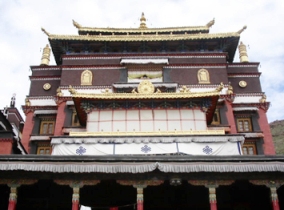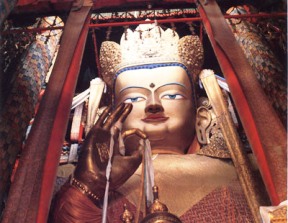Driving on the road far away from Shigatse, from the west city you can see the gold roof of Tashilunpo Monastery  shinning under the sunshine. Experiencing five centuries, it still maintains the magnificent vigor. Tashilhunpo Monastery (meaning auspicious) is one of the Six Big Monasteries of Gelugpa (or Yellow Hat Sect) in China and the biggest Tibetan Gelugpa Buddhism monastery in back Tibet area. Also called the Heap of Glory, the monastery is located at the foot of Drolmari (Tara's Mountain), Shigatse. shinning under the sunshine. Experiencing five centuries, it still maintains the magnificent vigor. Tashilhunpo Monastery (meaning auspicious) is one of the Six Big Monasteries of Gelugpa (or Yellow Hat Sect) in China and the biggest Tibetan Gelugpa Buddhism monastery in back Tibet area. Also called the Heap of Glory, the monastery is located at the foot of Drolmari (Tara's Mountain), Shigatse.
History:
Gendun Drubpa, the first Dalai Lama and a most outstanding disciple of Tsong Khapa founded Tashilhunpo Monastery in 1477. In 1600, the Fourth Panchen Lama started a large-scale expansion and his successors carried on. In 1713, the Chinese emperor finally ascertained the Fifth Panchen Lama’s title and status. The monastery became the seat of Panchen Lama. At its climax, there are 3,000 rooms with more than 5,000 lamas, above 50 underling temples and over 30 manors. From the Fourth Panchen Lama, all the successors take it as seat. The monastery now has a building space of 300 thousand square meters (3,229,279 sq. ft.). The main structures found in the Tashilhunpo Monastery are The Maitreya Chapel, The Panchen Lama's Palace and The Kelsang Temple. Tashilhunpo is the seat of the Panchen Lama since the Fourth Panchen Lama took charge in the monastery, and there are now nearly 800 lamas.
Location:
Tashilunpo Monastery is located on the southern slope of the Nyima Mountain to the west of the Shigatse city. (Gatehouse Tel: 0892-8222933)
How to Get There:
The Tashilhunpo Monastery is situated at the west part of Shigatse City; you can take a walk to the monastery or you could opt to travel by pedicab.
Admission Fee:
RMB 55 Yuan compromises a nice Tashilunpo Monastery introduction video or RMB 45 Yuan per one without the video. If you come during some important Tibetan festivals, such as Tibetan New Year, and Dancing Deity Festival, you may enter the monastery for free. No discount for students.
Opening Hours:
08:00 to 16:00 (closed for lunch from 12:00 to 14:00)
Recommended Time for a Visit:
Ordinary you need three hours, but the monastery is quite big with lots of things worth appreciation, so spend as much time as possible.
Tips:
1. Pictures taking is restricted. Generally, for photo it costs RMB 75 Yuan, and video RMB 1,500 Yuan. But you’d better firstly ask the lamas for permission.
2. Walk out of the monastery, turn left, visitors can see a line of jewelry booth, where you can pick up something you like carefully. Compared with Bajiao Street in Lhasa, here you can find more old style stuffs, such as Tibetan used bowl and headgears, old Thangka and so on. Usually you would have pleasantly surprising discovery. In addition the trove of thangkas, murals and other religious and artistic treasures certainly will impose an indelible impression upon visitors.
3. The Thangka Wall sits northeast of the monastery. The huge wall, 35 meters (115 feet) in height 40 meters (131 feet) in width, can be seen faraway. Founding in 1468, it was a memorial monument to commemorate the birth, nirvana and initiation into Buddhahood of Sakyamuni. On April fourteenth of Tibetan calendar every year, gigantic thangkas of Buddha will be displayed on the wall.
4. The Buddha Exhibit Festival (Buddha Basking) is also a famous festival both in and out of Tibet. Every year from May fourteenth to sixteenth, three Buddha will be exhibited per day.
5. when visiting, you can view from floor to floor, fist the biggest Jiangba Buddha, then walk around the mountain along Tashilhunpo Monastery. There are lots of dogs on the turning sutras bucket road. Aside the Buddha Basking Platform you can overlook the Tashilhunpo Monastery and Shigatse. Besides the main palaces, there are lots of rooms with complicated layout. It's easy to get lost in the grand palace, so please be careful!
6. Lots of the rooms in the monastery are locked. You can ask the lama to open for you(although not everyone can succeed, you can have a try!). In front of the monastery there is a street running only at night. |
